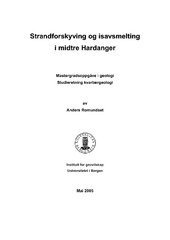| dc.contributor.author | Romundset, Anders | eng |
| dc.date.accessioned | 2006-06-06T12:54:51Z | |
| dc.date.available | 2006-06-06T12:54:51Z | |
| dc.date.issued | 2005 | eng |
| dc.identifier.isbn | 82-8088-514-5 (electronic version) | en_US |
| dc.identifier.uri | https://hdl.handle.net/1956/1206 | |
| dc.description.abstract | A new Holocene relative sea-level (RSL) curve is drawn, based on three firmly dated isolation basins in mid-Hardangerfjorden, southwest Norway. Several AMS-datings of Betula leaves from each isolation contact yielded very consistent ages. Following deglaciation, RSL at the site fell very rapidly a total of about 70 m during the Preboreal. The regression rate then slowed down considerably during a time span of ca. 1000 years, and a slow and even regression has taken place from then until present. No evidence of the the Tapes transgression is seen in the investigated stratigraphies, although a possible transgression or stillstand of the RSL cannot be ruled out on basis of merely these three isolation basins. The RSL curve is placed together with two other curves from the outer coast, and on this foundation a Holocene shoreline diagram representative for Hardangerfjorden is constructed. A deduced shoreline gradient curve displays a rapid decrease in the tilting of the shorelines (1,4 – 0,2 m/km) during the course of the first ca. 3000 years. From then on, the tilt has been steadily decreasing until present. Marine shells were obtained from the lowermost glaciomarine sediments in the cores. Eight datings were performed, all yielding early Preboreal ages. This indicates a final deglaciation of the area at the transition from the Weichselian to the Holocene, and supports the hypothesis of a glacier occupying Hardangerfjorden some time during the Younger Dryas. The Storegga tsunami is believed to have reached Hardangerfjorden, but no clear evidence has been found for this event. | en_US |
| dc.description.abstract | Ei ny kurve er teikna for strandforskyvinga gjennom holosen i Tørvikbygd, midtre Hardanger. Kvar isolasjonskontakt er tidfest med ei rekkje AMS 14C-dateringar av bjørkeblad. Dateringane gav svært konsistente aldrar for isolasjonane. Det relative havnivået i Tørvikbygd fall fyrst raskt omlag 70 m gjennom preboreal. Deretter bremsa regresjonen markert opp over omlag tusen år, og vidare utover i holosen har det vore ein mykje seinare og jamn regresjon. Det er ikkje funne teikn til at tapestransgresjonen nådde inn til Tørvikbygd, men dette kan heller ikkje utelukkast med grunnlag i desse tre undersøkte bassenga. Strandforskyvingskurva er stilt saman med to andre kurver, frå sør og nordaust på Bømlo. Desse tre lokalitetane utgjer grunnlaget for konstruksjonen av eit nytt strandlinediagram for Hardangerfjorden. Ei utleidd kurve for strandlinegradienten syner at endringa av skråstillinga var rask dei fyrste omlag 3000 åra (1,4 – 0,2 m/km), medan hallinga vidare gjennom holosen har endra seg seint og med ein nær jamn rate. Det er gjort åtte dateringar av marine skjel frå glasimarine sediment i botnen av fire ulike kjerner, og samtlege gav aldrar frå tidleg preboreal. Det tyder på at isen smelta vekk frå Tørvikbygd ved overgangen frå weichsel til holosen, og stør hypotesen som seier at Hardangerfjorden var fylt av ein fjordbre ein gong i yngre dryas. Det er ikkje påvist avsettingar etter Storeggatsunamien i nokon av bassenga. | no_NO |
| dc.format.extent | 951148 bytes | eng |
| dc.format.mimetype | application/pdf | eng |
| dc.language.iso | nno | eng |
| dc.publisher | The University of Bergen | en_US |
| dc.title | Strandforskyving og isavsmelting i midtre Hardanger | no_NO |
| dc.type | Master thesis | |
| dc.rights.holder | The author | en_US |
| dc.rights.holder | Copyright the author. All rights reserved | en_US |
| dc.subject.nsi | VDP::Matematikk og Naturvitenskap: 400::Geofag: 450 | nob |
